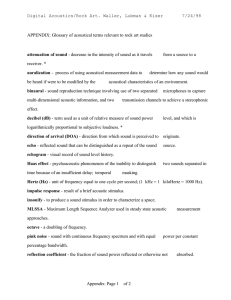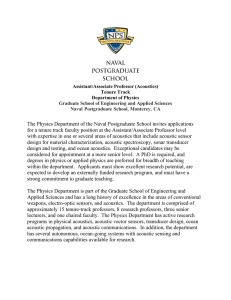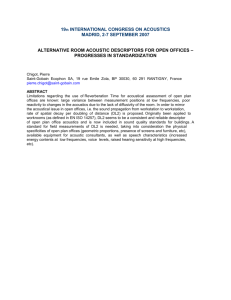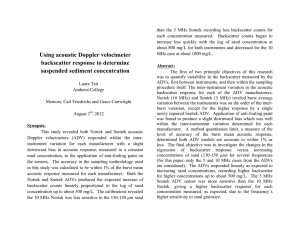Document 12779578
advertisement
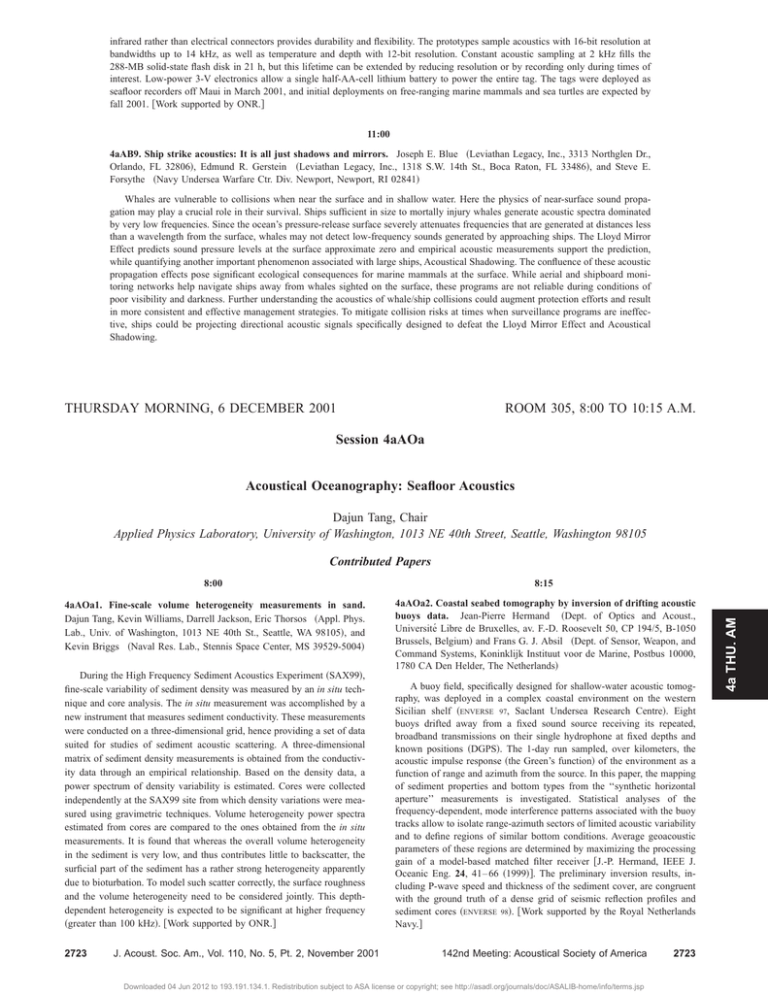
infrared rather than electrical connectors provides durability and flexibility. The prototypes sample acoustics with 16-bit resolution at bandwidths up to 14 kHz, as well as temperature and depth with 12-bit resolution. Constant acoustic sampling at 2 kHz fills the 288-MB solid-state flash disk in 21 h, but this lifetime can be extended by reducing resolution or by recording only during times of interest. Low-power 3-V electronics allow a single half-AA-cell lithium battery to power the entire tag. The tags were deployed as seafloor recorders off Maui in March 2001, and initial deployments on free-ranging marine mammals and sea turtles are expected by fall 2001. 关Work supported by ONR.兴 11:00 4aAB9. Ship strike acoustics: It is all just shadows and mirrors. Joseph E. Blue 共Leviathan Legacy, Inc., 3313 Northglen Dr., Orlando, FL 32806兲, Edmund R. Gerstein 共Leviathan Legacy, Inc., 1318 S.W. 14th St., Boca Raton, FL 33486兲, and Steve E. Forsythe 共Navy Undersea Warfare Ctr. Div. Newport, Newport, RI 02841兲 Whales are vulnerable to collisions when near the surface and in shallow water. Here the physics of near-surface sound propagation may play a crucial role in their survival. Ships sufficient in size to mortally injury whales generate acoustic spectra dominated by very low frequencies. Since the ocean’s pressure-release surface severely attenuates frequencies that are generated at distances less than a wavelength from the surface, whales may not detect low-frequency sounds generated by approaching ships. The Lloyd Mirror Effect predicts sound pressure levels at the surface approximate zero and empirical acoustic measurements support the prediction, while quantifying another important phenomenon associated with large ships, Acoustical Shadowing. The confluence of these acoustic propagation effects pose significant ecological consequences for marine mammals at the surface. While aerial and shipboard monitoring networks help navigate ships away from whales sighted on the surface, these programs are not reliable during conditions of poor visibility and darkness. Further understanding the acoustics of whale/ship collisions could augment protection efforts and result in more consistent and effective management strategies. To mitigate collision risks at times when surveillance programs are ineffective, ships could be projecting directional acoustic signals specifically designed to defeat the Lloyd Mirror Effect and Acoustical Shadowing. THURSDAY MORNING, 6 DECEMBER 2001 ROOM 305, 8:00 TO 10:15 A.M. Session 4aAOa Acoustical Oceanography: Seafloor Acoustics Dajun Tang, Chair Applied Physics Laboratory, University of Washington, 1013 NE 40th Street, Seattle, Washington 98105 8:00 8:15 4aAOa1. Fine-scale volume heterogeneity measurements in sand. Dajun Tang, Kevin Williams, Darrell Jackson, Eric Thorsos 共Appl. Phys. Lab., Univ. of Washington, 1013 NE 40th St., Seattle, WA 98105兲, and Kevin Briggs 共Naval Res. Lab., Stennis Space Center, MS 39529-5004兲 4aAOa2. Coastal seabed tomography by inversion of drifting acoustic buoys data. Jean-Pierre Hermand 共Dept. of Optics and Acoust., Université Libre de Bruxelles, av. F.-D. Roosevelt 50, CP 194/5, B-1050 Brussels, Belgium兲 and Frans G. J. Absil 共Dept. of Sensor, Weapon, and Command Systems, Koninklijk Instituut voor de Marine, Postbus 10000, 1780 CA Den Helder, The Netherlands兲 During the High Frequency Sediment Acoustics Experiment 共SAX99兲, fine-scale variability of sediment density was measured by an in situ technique and core analysis. The in situ measurement was accomplished by a new instrument that measures sediment conductivity. These measurements were conducted on a three-dimensional grid, hence providing a set of data suited for studies of sediment acoustic scattering. A three-dimensional matrix of sediment density measurements is obtained from the conductivity data through an empirical relationship. Based on the density data, a power spectrum of density variability is estimated. Cores were collected independently at the SAX99 site from which density variations were measured using gravimetric techniques. Volume heterogeneity power spectra estimated from cores are compared to the ones obtained from the in situ measurements. It is found that whereas the overall volume heterogeneity in the sediment is very low, and thus contributes little to backscatter, the surficial part of the sediment has a rather strong heterogeneity apparently due to bioturbation. To model such scatter correctly, the surface roughness and the volume heterogeneity need to be considered jointly. This depthdependent heterogeneity is expected to be significant at higher frequency 共greater than 100 kHz兲. 关Work supported by ONR.兴 2723 J. Acoust. Soc. Am., Vol. 110, No. 5, Pt. 2, November 2001 A buoy field, specifically designed for shallow-water acoustic tomography, was deployed in a complex coastal environment on the western Sicilian shelf 共ENVERSE 97, Saclant Undersea Research Centre兲. Eight buoys drifted away from a fixed sound source receiving its repeated, broadband transmissions on their single hydrophone at fixed depths and known positions 共DGPS兲. The 1-day run sampled, over kilometers, the acoustic impulse response 共the Green’s function兲 of the environment as a function of range and azimuth from the source. In this paper, the mapping of sediment properties and bottom types from the ‘‘synthetic horizontal aperture’’ measurements is investigated. Statistical analyses of the frequency-dependent, mode interference patterns associated with the buoy tracks allow to isolate range-azimuth sectors of limited acoustic variability and to define regions of similar bottom conditions. Average geoacoustic parameters of these regions are determined by maximizing the processing gain of a model-based matched filter receiver 关J.-P. Hermand, IEEE J. Oceanic Eng. 24, 41– 66 共1999兲兴. The preliminary inversion results, including P-wave speed and thickness of the sediment cover, are congruent with the ground truth of a dense grid of seismic reflection profiles and sediment cores 共ENVERSE 98兲. 关Work supported by the Royal Netherlands Navy.兴 142nd Meeting: Acoustical Society of America Downloaded 04 Jun 2012 to 193.191.134.1. Redistribution subject to ASA license or copyright; see http://asadl.org/journals/doc/ASALIB-home/info/terms.jsp 2723 4a THU. AM Contributed Papers
